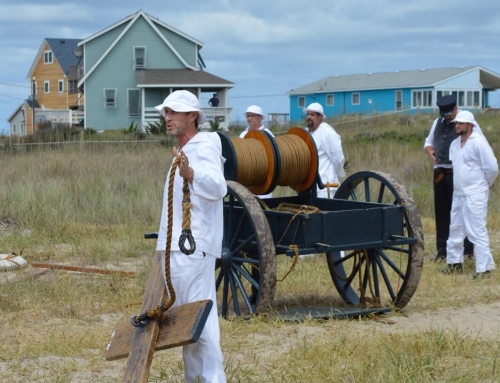North Carolina receives its first seven stations
On April 20, 1871, Congress voted an appropriation of $200,000 for Life-Saving purposes. Sumner Increase Kimball was nominated by President Ulysses S. Grant, and without going through the committee process was confirmed as General Superintendent of Life-Saving Service. Of the twelve Districts formed, the Sixth District was comprised of Virginia and North Carolina and funds were appropriated to begin building Life-Saving Stations in the Sixth District in 1874.
On November 15, 1871 Francis W. Chandler was added to the staff as Assistant Architect at $8.00 per day. Chandler was a European-trained Architect with a great understanding of classic architecture, which was clearly reflected in his work. The 1874 station at Chicamacomico is one of his early designs.
By 1874, funds were appropriated to begin building Life-Saving Stations in North Carolina. The first seven Stations were to be built of wood without “much reference to architectural effect, but designed to withstand the tempest, and afford comfortable quarters for the surfmen and convenient rooms for the apparatus.” The design of the building is called timber frame. This design was developed in the Northeast and found to able to stand the worst of weather conditions. The frames were made in a mill in New Bern, NC. On the first floor there was a boat room and a “day room”, which was the kitchen, dining room, and recreation room all-in-one; on the second floor were found the keeper’s office, keeper’s quarters, and the sleeping quarters for the crew and shipwreck survivors. An open platform lookout tower for the day-watch was placed upon the roof, and there was a flagstaff for signaling. A drill pole was erected for the purpose of practicing rescue techniques with the beach-apparatus. The station’s equipment was usually comprised of two boats with outfits, a life-car, two sets of breeches-buoys, a mortar and cart, cork life jackets, heaving-sticks, Coston signal flares, rockets, signal flags, barometer, thermometer, and necessary furniture.
Superintendents were to be a resident of the District, of good character, not less than 25 or more than 55 years old when appointed. The first crews were comprised of six surfmen. They were to cover the “worst three months of the year”. The keeper was hired for the full year.
The first ten stations in District Six were built with three in Virginia and seven in North Carolina. James H. Boyle, a Northern contractor who had recently relocated to New Bern, NC, bid $2,375.00 for each house. When a compliance bond of $30,000.00 was required Mr. Boyle was not able to secure bondsmen. He in turn proposed the government retain $400.00 per house until completed. His main problem was that the “moneyed people” of New Bern had no use for people such as he, who had moved South after Federal troops had occupied the area.
When Boyle found the inter-coastal schooners avoided the Outer Banks during winter months his schedule was upset. Without the schooners able to deliver lumber and supplies, his promise of completing a station “one a month starting in September” was not to be. Secretary Richardson sanctioned concessions provided he completed three buildings by December 1, 1873. If he did not, he was to pay $25.00 per house per day. This was accepted August 23, 1873. On September 23, Lieutenant Lewis M. Stodder found Boyle “was putting up the frames of stations regardless of the proper sites or dimensions of houses, not having proper plans to work by.”
Stodder requested permission to charter a vessel to carry him to Hatteras Island. There was no means of subsistence on the island, so the vessel would also have to provide “the necessary means of living whilst there.” The cost was $13.00 per day and was decided this was too expensive. The Revenue sloop Saville, under Lieutenant Walter Walton’s command, was assigned the task. Before the sloop arrived, Stodder traveled to Hatteras with a different set of plans. His orders to Boyle were that the almost-completed house would have to come down and then raised eighteen inches. The contractor did as he was told. Within a few days another set of plans arrived and Stodder had Boyle suspend all work. The weather then turned so cold that the crew went home. In November, the Saville sailed along the North Carolina coast selecting appropriate station locations. When they disembarked at Little Kinnakeet, Stodder refused to go ashore to inspect the station and Lt. Walton was promptly appointed Superintendent.
Chicamacomico 1874 Station
Boyle returned to Little Kinnakeet and resumed work on the station with T.J. Gardner as foreman. By mid-March 1874 the crew of twenty workers was moved to Chicamacomico. The location chosen for the station was public land with no deeded ownership. On the 19th Gardner and his nineteen workers quit and went home. They left because of Boyle’s “utter indifference to the progress of the work, in that he did not provide for the good comfort and sustenance of the men; and in making dray horses of carpenters, the work was delayed derogative to their interests.” Moreover, Boyle had failed to have on hand a sufficient supply of lumber of suitable quality and dimensions. One-half the frames on hand were “black, mildewed, sappy, unevenly cut, unsuitable size and knotty and some of it badly warped from careless stacking.” None of this material was used in the final construction. The straw that broke the camel’s back was when an armed Mr. Boyle had walked into the workmen’s quarters and accused Gardner of having conspired to make the men dissatisfied.
On April 23, 1874, D. Simpson was awarded the contract to build Chicamacomico, Oregon Inlet and Nags Head stations. A. A. McCulloch of Norfolk, VA, built Jones Hill station (later called Currituck Beach), Caffey’s Inlet, Kitty Hawk and the three Virginia stations. On the third week in October 1874 all ten stations were complete. Chicamacomico was commissioned December 4, 1874 with Benjamin Pugh as Keeper. Keeper Pugh stayed until 1879 when he was appointed keeper of another station. Little Banister “Capt. Ban” Midgett, III was appointed the next keeper at Chicamacomico in 1879.
The building had extensive maintenance done in July 1884. The lookout, boat room platform, doors to the boat room, and floors in the mess room, keeper’s room and sleeping room were replaced for $93.30.
On January 13, 1885, openings were cut to replace the single window blocked by the stovepipe. On the 21st the windows were finished.
On April 25, 1888, work began on the oil house and was completed three days later. Keeper Little Bannister Midgett, III, who was ill, was replaced in 1888 by Keeper Josiah Wescott.
On October 6, 1892, work began on the cookhouse and cart shed. The cookhouse was to be 14×18 feet. The building was finished on the 26th. The interior had one coat of linseed oil. The cooking range was moved into the building as soon as the oil dried. The Cart House was finished on December 20, 1892.
In 1894, after recovering from his illness, Little Bannister Midgett, III resumed his role as Keeper of the Chicamacomico Station.
On May 4, 1896, lumber for the Boathouse was landed at New Inlet. The boathouse measured 30×8 feet and was completed by May 26, 1897.
On August 17, 1899, during the hurricane, the building “went down” and the sea tide swept around the station, threatening at any moment to wash it away. At 6 P.M. the door blew off the cookhouse. The boathouse was thrown thirty feet from its foundation. The stable did not suffer much from the storm but needed a new floor and roof. The kitchen steps were lost. The station roof and sides leaked as it was in very bad condition throughout and had already been condemned. Battens were added to the building to control the leaks in the walls. In 1911, a fire broke out on the East Side of the station roof. The crew equipped themselves with two Underwriter Fire Extinguishers, Harden Hand Grenades, and fire buckets. The fire had ignited from sparks in the chimney, and roof repairs were made at once.
On March 16, 1908, the cook, cleaning up after the noon meal, shut the door to the kitchen and walked over to the station. At 2:30 the cook glanced out the window and saw smoke billowing from under the cookhouse.
On November 2, 1911, the crew moved the old cookhouse to its new site, west of the new station building. After being blocked it would serve as an oil house. 4,500 shingles and forty-five pounds of No.5 galvanized nails were used to reshingle the building.
On February 1, 1912, Superintendent of Construction D.P. Foley recommended that the old station be razed and “its materials with such materials as may be necessary used in the construction of a boathouse on the beach in front of the new station.”
In 1913, the soundside boathouse was moved to its present location next to N.C. Highway 12 and was used to house a smaller vessel with which to affect rescues on the Pamlico Sound. The 1874 Station was called the “boathouse” when the 1911 station was made operational, but it properly is now called the 1874 Station.
In 1915, the U.S. Life-Saving Service and the Revenue Cutter Service merged to become the United States Coast Guard and John Allen Midgett, Jr. was appointed as Captain (Keeper) of the Station.
In 1917, the supply vessel Carolina landed forty “gum rollers” to be used to move the old 1874 station 960 yards to bring it abreast of the new 1911 station. The move began the afternoon of April 22, 1918 and was finished one month later. No repairs were authorized as the building only housed the gear from the decommissioned New Inlet Station.
On August 16, 1918, the British tanker Mirlo was sunk by the German submarine U-117. The rescue of 42 of 51 British sailors is considered one of the greatest rescues of WWI and the early Coast Guard. This amazing, heroic rescue is told in other papers.
In 1928 W.H. Bartlett, an Elizabeth City contractor, was allotted $236.00 to “furnish such new material as is required and all the skilled labor, and assist the crew to construct a lean-to on the beach boathouse (the original 1874 station) 26′ 4″ long by 10′ wide, conforming to kind and quality of present construction of the present boat house”. This lean-to was constructed on the west side of the old station and abutted on the lean-to built in the 1884 or 1885. The lean-to extended six feet from the house and was twenty feet in length. Besides giving access to the house, this lean-to provided two new small rooms. To the right of the entrance was a pantry and to the left a “Dry Room for Wet Clothes.”
The second building from Highway 12, called the tractor building, was built in 1932.
The cart house was wrecked by the storm of May 10, 1933.
In May 1934, comments were made by Commander McCabe that there was an “aerial identification platform” on the roof of the old station.
In December 1938, Capt. John Allen Midgett, Jr., while on a trip to Norfolk, VA to buy Christmas presents, was killed in a car accident. Levene Midgett took over the position of Captain of the Station and remained so until the station was decommissioned in 1954.
In 1939 the interior of the old station was painted. Also 100 gallons of green roofing paint was used to paint roofs on all buildings that were originally painted white.





